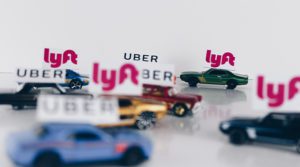3 FAQs About Lyft & Uber Accidents Involving Pedestrians

Pedestrian accidents might seem rare, but they happen far more often than many people realize. On average, one pedestrian dies in a traffic crash every 1.5 hours in the United States, and this doesn’t account for the many thousands of non-fatal injuries. If you were harmed in a pedestrian accident that involved an Uber or Lyft vehicle, you probably have a lot of questions about your claim.
Read on to learn the answers to some of the most frequently asked questions about these cases.
1. Can I Sue Uber or Lyft?
No. Even if it is determined that the rideshare driver caused the accident while transporting a paying passenger, you would not be able to sue Uber or Lyft directly. This is because the doctrine of respondeat superior, or vicarious liability, does not apply to independent contractors.
When a person is classified as an employee, their employer might be liable for any damages they cause in an accident while performing duties within the course and scope of their employment. However, when the liable party is an independent contractor, the party that has contracted out their services is not subject to vicarious liability.
Rideshare drivers are independent contractors. Fortunately, Uber and Lyft both have commercial auto insurance policies that pay out benefits when a driver causes an accident while:
- En route to pick up a passenger,
- Transporting a passenger, or
- Dropping off a passenger.
There is also coverage that applies when the driver is waiting for a fare, though the coverage limits in that scenario are lower.
In other words, if the rideshare driver caused the accident and one of the above-three circumstances applies to your case, you would likely bring a claim against the rideshare company’s commercial auto insurance policy. If, however, the driver’s app was off when the crash happened—i.e. they were not offering rideshare services—the claim would most likely be brought against the driver’s liability insurance coverage.
2. Can I Recover Damages If I Was Hit While Jaywalking?
Maybe. The answer depends on whether the other party was at least partially liable for the damages.
Because jaywalking is illegal and puts you at a higher risk of getting hit, it is usually considered negligent. Therefore, it is likely that you would be assigned a percentage of fault. Because Florida is a pure comparative negligence state, personal injury plaintiffs can recover even if they were 90 percent liable; however, their award of damages is reduced by their percentage of fault.
A skilled pedestrian accident lawyer can perform a thorough investigation and compile all evidence of negligence and liability. It will be your attorney’s job to demonstrate how the defendant’s negligence contributed to the accident. Even if you were jaywalking, you may be able to obtain monetary damages if your lawyer can prove:
- The Defendant Was Speeding: If the rideshare driver was breaking the speed limit when the crash occurred, it may be determined that the accident would not have happened or the injuries would have been less severe if they had been obeying the law. Evidence to prove speeding might include photographs of skid marks, pictures of property damage, and surveillance footage.
- The Defendant Was Intoxicated: It is well-established that alcohol and other kinds of drugs slow down a person’s reaction time and impair their decision-making. If the rideshare driver was under the influence, your attorney might use toxicology reports and the accident report to prove how their impairment contributed to the accident. In this scenario, it may be possible to obtain punitive damages in addition to compensatory damages.
- The Defendant Was Distracted: Texting and other types of cellphone use are leading causes of pedestrian accidents in Florida. Evidence of cellphone use might include surveillance footage, deposition from rideshare passengers, and cellphone records.
- A Reasonable Person Would Have Taken Evasive Action: The fact that a pedestrian is jaywalking does not release a driver from their duty to exercise reasonable care. What constitutes “reasonable care” depends on the circumstances, but if your lawyer can prove that a person of ordinary prudence would have behaved differently, and this would have resulted in a better outcome, the defendant might be found negligent and liable. This might apply to your case if the accident happened during the day, you were clearly visible, and the driver had plenty of time to stop or take other evasive action.
Much of the evidence mentioned above could be difficult to obtain without applying legal pressure. For example, the liable driver’s cellphone company might be reluctant to hand over their records. If a surveillance camera filmed the crash, there’s no guarantee that the owner of that film will relinquish it voluntarily. Your pedestrian accident lawyer can help you file a subpoena for evidence that is being withheld.
3. What Evidence Might Be Needed to Build My Claim?
If you intend to bring a claim against the liable party or their insurance provider, you would need to prove liability, causation, and damages to obtain a recovery. Liability means legal responsibility, and it is typically established in rideshare accident cases by proving negligence. Causation means the damages being sought would not have happened but for the tort. Compensatory damages refer to the kinds of losses suffered by the plaintiff, and punitive damages are awarded in some cases to punish the defendant and to prevent similar misconduct in the future.
Evidence of liability might include:
- The Accident Report: This is a record of facts and observations created by responding law enforcement officers. It should contain essential details about where, how, and when the accident happened. It might include an officer’s suspicions regarding whether the liable driver was texting, under the influence, or engaging in some other negligent behavior. It could also contain eyewitness statements.
- Cellphone Records: The best pedestrian accident attorneys understand that many of these crashes can be attributed to cellphone use. These records often play an integral role in proving negligence and liability.
- Eyewitness Deposition: If a dispute arises regarding who was responsible for the accident, the deposition of eyewitnesses might corroborate your version of events.
- Photos of the Crash Scene: Pictures of the scene can provide valuable insight into how the collision happened. Skid marks, for example, can help your lawyer and perhaps an accident reconstruction expert determine the speed the vehicle was traveling before impact. Photos of property damage could shed light not only on vehicle speed but also on the angle at which the pedestrian was hit. An accident reconstruction expert may be brought in to evaluate photos and other evidence and to provide deposition.
- Deposition from the Parties Involved in the Accident: Your lawyer might depose the rideshare driver and passengers regarding what they saw and what the driver was doing in the moments leading up to the wreck.
- Surveillance Footage: There might be recordings from nearby surveillance cameras that captured the accident.
Evidence of causation might include:
- Medical Expert Witness Deposition: A dispute over causation might arise if you had an injury or illness that was exacerbated in the accident. Should this be the case, your lawyer will have to prove the degree to which your preexisting condition was exacerbated and approximate a fair settlement amount for the resulting damages. If the insurance company disputes causation or the proposed settlement figure, your lawyer might use expert witness deposition to demonstrate the effect that the accident had on your preexisting condition.
- Photos of Injuries: Pictures of injuries can help your attorney tie them to the accident.
- Your Medical Records: Diagnostic imaging, lab test results, and other records can show that your preexisting medical condition was exacerbated in the accident.
Evidence of damages might include:
- Medical Bills: Any reasonable and necessary medical costs you incurred as a result of the accident might be recoverable. These may include bills for hospital stays, surgeries, physical therapy, psychotherapy, occupational therapy, and prescription medications.
- Financial Records: Your lawyer will need documentation to prove that you have missed work and to estimate the value of lost income. Sometimes it is possible to obtain compensation for loss of future wages and benefits.
- Receipts: Any receipts for costs arising from the accident will contribute to your claim.
- Expert Witness Deposition: Your attorney might need to depose financial, vocational, and medical experts to prove the value of your damages. Expert witness deposition is particularly valuable in cases that involve catastrophic or permanent injuries, which commonly occur in pedestrian accidents.
Discuss Your Claim with an Uber or Lyft Accident Lawyer in Stuart
If you were hurt in a pedestrian accident that involved a rideshare vehicle, contact the attorneys at Weston & Pape. No matter the circumstances of the collision, we have the experience and resources to help you pursue the highest possible settlement or verdict.
We don’t charge anything upfront for our legal services, and if we don’t win your case, no attorneys’ fees will be owed. To schedule a free consultation with an injury lawyer in Stuart, send us a message or call 772-266-5555.

 Call Us Today
- It's Free
Call Us Today
- It's Free